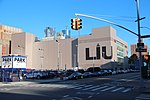Brooklyn Technical High School
Brooklyn Technical High School, commonly called Brooklyn Tech and administratively designated High School 430, is an elite New York City public magnet high school that specializes in science, technology, engineering, and mathematics. It is one of three original specialized high schools operated by the New York City Department of Education, along with Stuyvesant High School and the Bronx High School of Science. Brooklyn Tech is considered one of the country's most prestigious and selective high schools. Brooklyn Tech is ranked #2 in New York City and #22 overall in the United States for college readiness and graduation rates.Admission to Brooklyn Tech involves taking the Specialized High Schools Admissions Test and scoring the cutoff for Brooklyn Tech. Each November, about 30,000 eighth and ninth graders take the 3-hour test for admittance to eight of the nine specialized high schools. About 1,900 to 1,950 students are admitted each year. Brooklyn Tech counts top scientists, inventors, innovators, Fortune 500 company CEOs and founders, high-ranking diplomats, academic scholars, literary and media figures, professional athletes, National Medal recipients, Nobel laureates, and Olympic medalists among its alumni.
Excerpt from the Wikipedia article Brooklyn Technical High School (License: CC BY-SA 3.0, Authors).Brooklyn Technical High School
Fort Greene Place, New York Brooklyn
Geographical coordinates (GPS) Address Nearby Places Show on map
Geographical coordinates (GPS)
| Latitude | Longitude |
|---|---|
| N 40.688888888889 ° | E -73.976944444444 ° |
Address
Fort Greene Place 32
11217 New York, Brooklyn
New York, United States
Open on Google Maps









